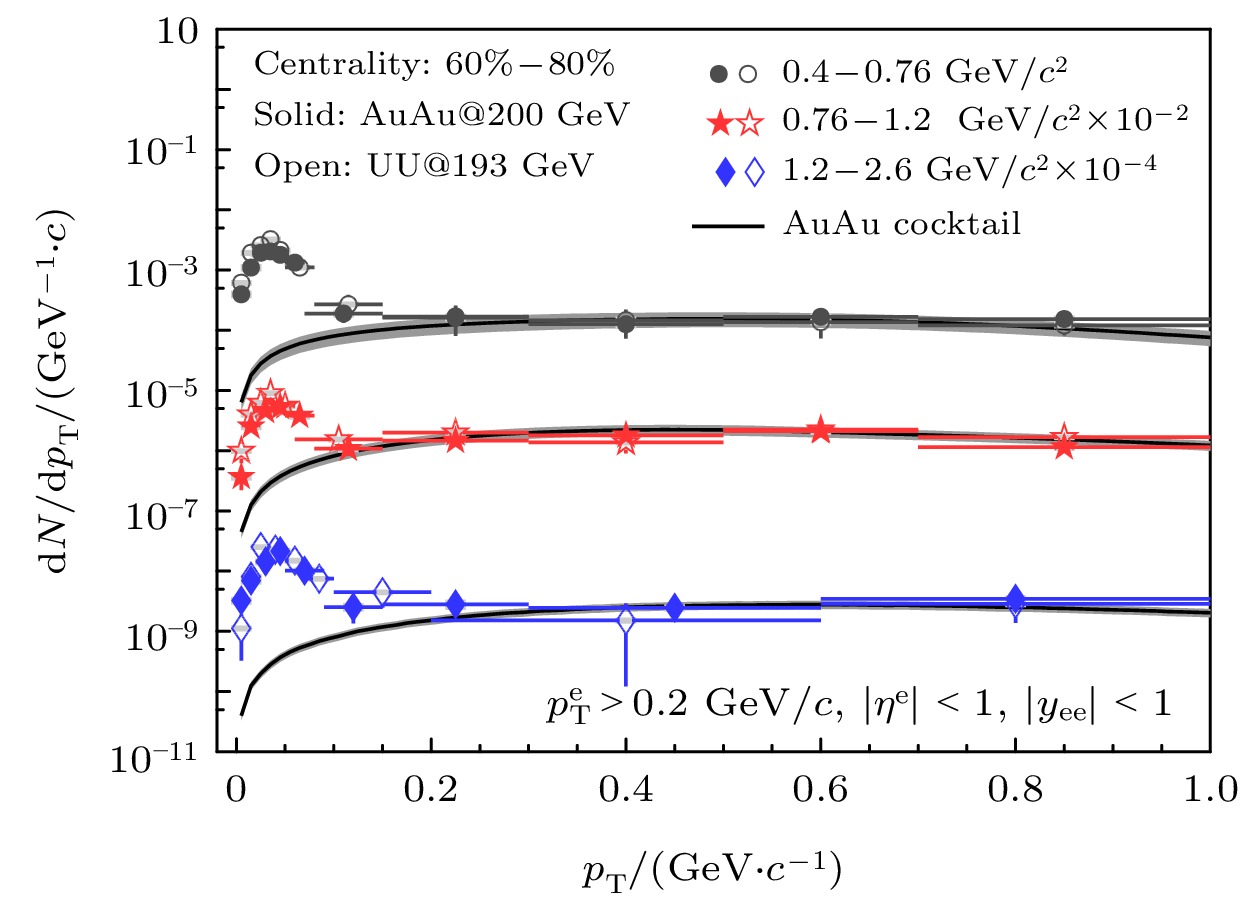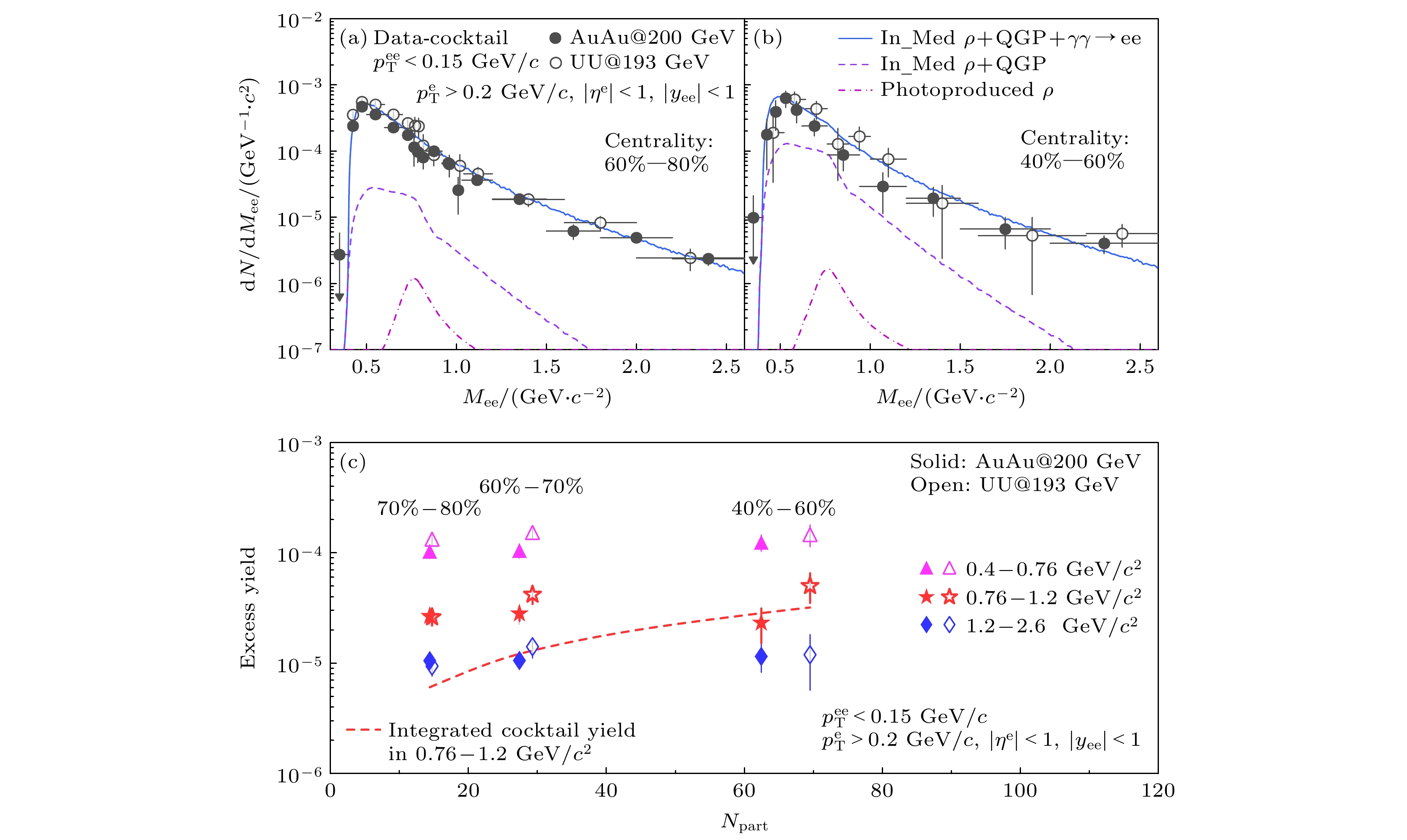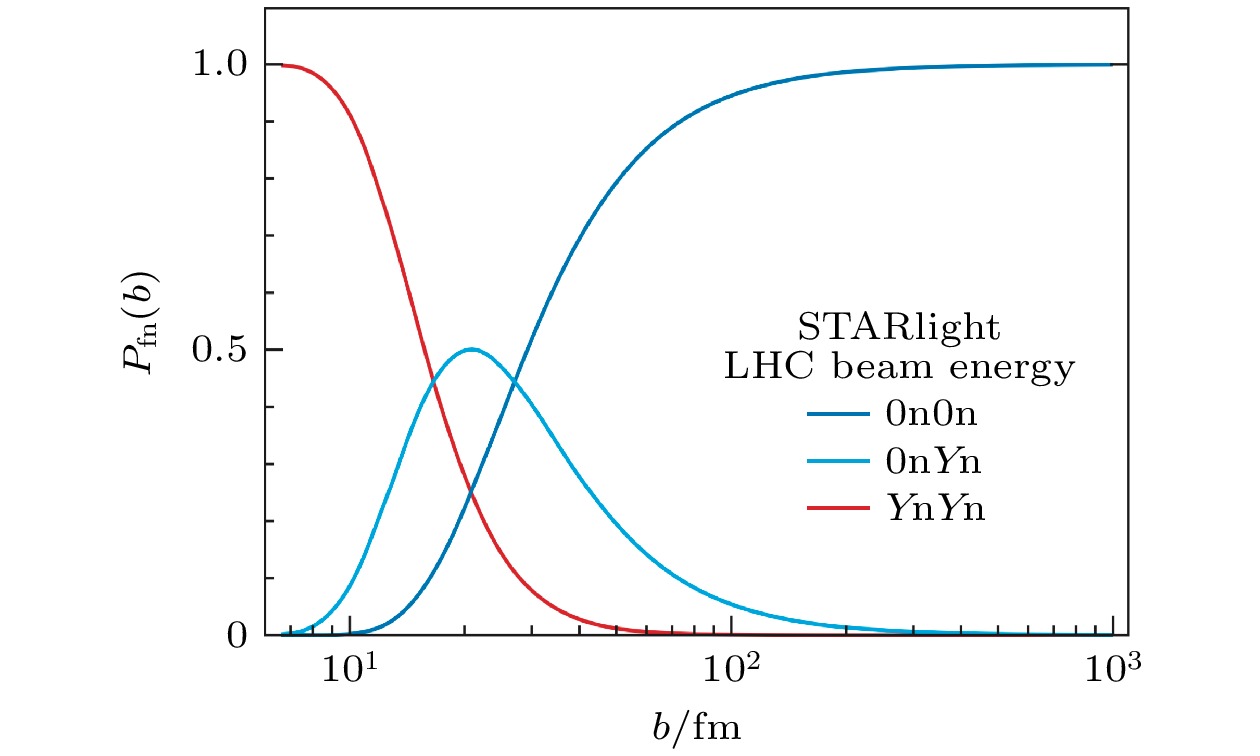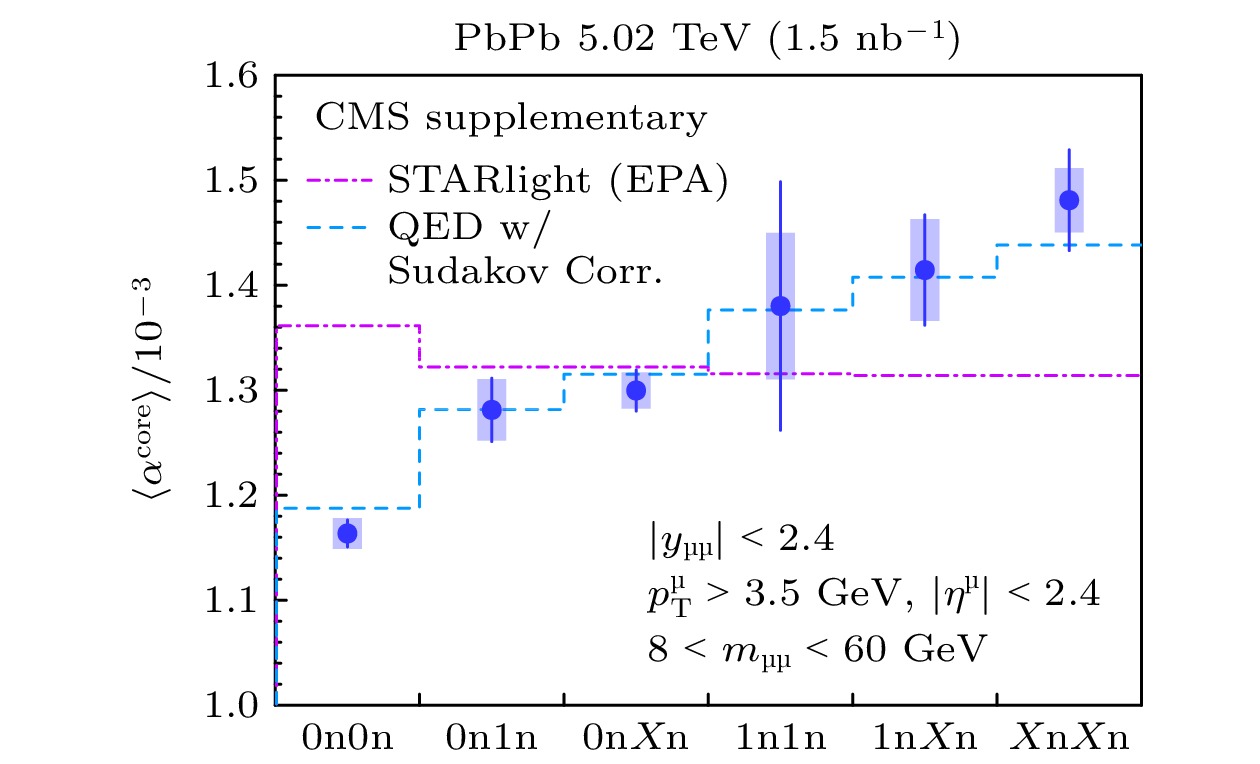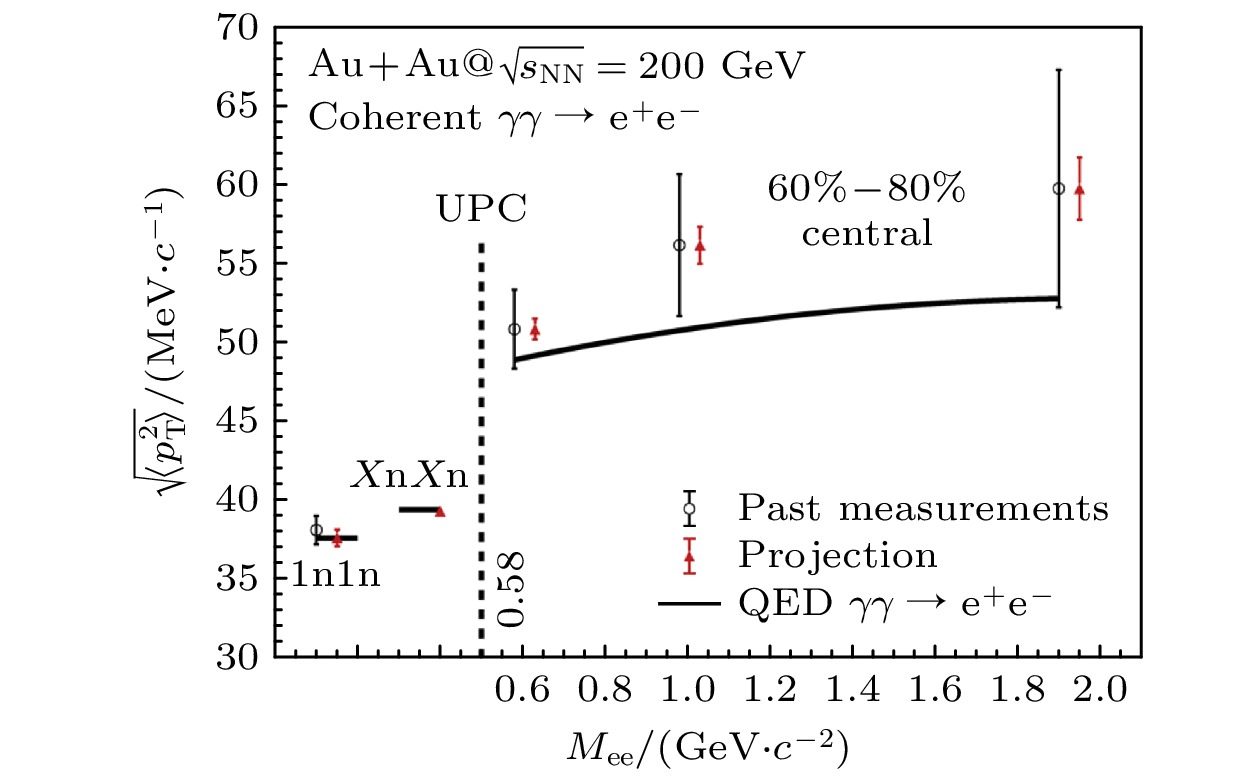-
在相对论重离子碰撞中, 接近光速的重离子产生的超强电磁场, 由于洛伦兹收缩效应可等效为线性极化的准实光子, 进而诱发光子-光子相互作用产生正负轻子对. 相对论重离子对撞机RHIC和大型强子对撞机LHC上的国际合作实验在非超周边重离子碰撞中观测到相干光致产生过程, 发现正负轻子对的横动量分布相比于其在超周边碰撞发生显著的展宽, 为研究解禁闭物质——夸克胶子等离子体的电磁性质提供了新途径. 本文主要回顾相对论重离子碰撞中光子-光子相互作用对碰撞参数依赖的实验研究, 并讨论其在侦测夸克胶子等离子体电磁性质方面的重要意义.The Lorentz-boosted electromagnetic fields surrounding relativistic heavy ions with large charges can be treated as a flux of linearly polarized quasireal photons, which can interact via the photon-photon scattering to produce lepton antilepton pairs. Those photon-photon interactions can happen even in heavy-ion collisions with hadronic overlap, making an opportunity to probe the electromagnetic properties of the produced deconfined quark-gluon plasma. In this paper, we review the recent experimental progress of the impact parameter dependent photon-photon interactions in heavy-ion collisions, and discuss their essential role in probing the possible electromagnetic properties of quark-gluon plasma produced in hadronic heavy-ion collisions.
-
Keywords:
- relativistic heavy-ion collisions /
- quark gluon plasma /
- photon-photon interactions /
- foward neutron tagging /
- dilepton
[1] Fermi E 1924 Z. Phys. 29 315
 Google Scholar
Google Scholar
[2] Williams E J 1934 Phys. Rev. 45 729
 Google Scholar
Google Scholar
[3] Weizsacker C F von 1934 Z. Phys. 88 612
 Google Scholar
Google Scholar
[4] Bertulani C A, Baur G 1988 Phys. Rep. 163 299
 Google Scholar
Google Scholar
[5] Baur G, Hencken K, Trautmann D, Sadovsky S, Kharlov Y 2002 Phys. Rep. 364 359
 Google Scholar
Google Scholar
[6] Bertulani C A, Klein S R, Nystrand J 2005 Annu. Rev. Nucl. Part. Sci. 55 271
 Google Scholar
Google Scholar
[7] Baltz A J, Baur G, d’Enterria D, Frankfurt L, Gelis F, Guzey V, Hencken K, Kharlov Y, Klasen M, Klein S R, Nikulin V, Nystrand J, Pshenichnov I A, Sadovsky S, Scapparone E, Seger J, Strikman M, Tverskoy M, Vogt R, White S N, Wiedemann U A, Yepes P, Zhalov M 2008 Phys. Rep. 458 1
 Google Scholar
Google Scholar
[8] Klein S R, Steinberg P 2020 Annu. Rev. Nucl. Part. Sci. 70 323
 Google Scholar
Google Scholar
[9] Baur G, Hencken K, Trautmann D 2007 Phys. Rep. 453 1
 Google Scholar
Google Scholar
[10] STAR Collaboration 2004 Phys. Rev. C 70 031902
 Google Scholar
Google Scholar
[11] STAR Collaboration 2021 Phys. Rev. Lett. 127 052302
 Google Scholar
Google Scholar
[12] PHENIX Collaboration 2009 Phys. Lett. B 679 321
 Google Scholar
Google Scholar
[13] ALICE Collaboration 2013 Eur. Phys. J. C 73 2617
 Google Scholar
Google Scholar
[14] CMS Collaboration 2019 Phys. Lett. B 797 134826
 Google Scholar
Google Scholar
[15] ATLAS Collaboration 2017 Nat. Phys. 13 852
 Google Scholar
Google Scholar
[16] ATLAS Collaboration 2019 Phys. Rev. Lett. 123 052001
 Google Scholar
Google Scholar
[17] Bruce R, d'Enterria D, d’Roeck A, Drewes M, Farrar G R, Giammanco A, Gould O, Hajer J, Harland-Lang L, Heisig J, Jowett J M, Kabana S, Krintiras G K, Korsmeier M, Lucente M, Milhano G, Mukherjee S, Niedziela J, Okorokov V A, Rajantie A, Schaumann M 2020 J. Phys. G 47 060501
 Google Scholar
Google Scholar
[18] STAR Collaboration 2002 Phys. Rev. Lett. 89 272302
 Google Scholar
Google Scholar
[19] CMS Collaboration 2019 Eur. Phys. J. C 79 277
 Google Scholar
Google Scholar
[20] CMS Collaboration 2023 arXiv: 2303.16984 [nucl-ex
[21] CMS Collaboration 2023 Phys. Rev. Lett. 131 051901
 Google Scholar
Google Scholar
[22] STAR Collaboration 2017 Phys. Rev. C 96 054904
 Google Scholar
Google Scholar
[23] STAR Collaboration 2023 Sci. Adv. 9 eabq3903
 Google Scholar
Google Scholar
[24] ALICE Collaboration 2013 Phys. Lett. B 718 1273
 Google Scholar
Google Scholar
[25] ALICE Collaboration 2014 Phys. Rev. Lett. 113 232504
 Google Scholar
Google Scholar
[26] ALICE Collaboration 2019 Phys. Lett. B 798 134926
 Google Scholar
Google Scholar
[27] ALICE Collaboration 2021 Phys. Lett. B 817 136280
 Google Scholar
Google Scholar
[28] ALICE Collaboration 2023 arXiv: 2305.06169 [nucl-ex
[29] CMS Collaboration 2017 Phys. Lett. B 772 489
 Google Scholar
Google Scholar
[30] ALICE Collaboration 2016 Phys. Rev. Lett. 116 222301
 Google Scholar
Google Scholar
[31] ATLAS Collaboration 2018 Phys. Rev. Lett. 121 212301
 Google Scholar
Google Scholar
[32] ATLAS Collaboration 2023 Phys. Rev. C 107 054907
 Google Scholar
Google Scholar
[33] STAR Collaboration 2018 Phys. Rev. Lett. 121 132301
 Google Scholar
Google Scholar
[34] STAR Collaboration 2019 Phys. Rev. Lett. 123 132302
 Google Scholar
Google Scholar
[35] CMS Collaboration 2021 Phys. Rev. Lett. 127 122001
 Google Scholar
Google Scholar
[36] ATLAS Collaboration 2021 Phys. Rev. C 104 024906
 Google Scholar
Google Scholar
[37] Zha W, Brandenburg J D, Tang Z, Xu Z 2020 Phys. Lett. B 800 135089
 Google Scholar
Google Scholar
[38] Brandenburg J D, Zha W, Xu Z 2021 Eur. Phys. J. A 57 299
 Google Scholar
Google Scholar
[39] Li C, Zhou J, Zhou Y 2019 Phys. Lett. B 795 576
 Google Scholar
Google Scholar
[40] Li C, Zhou J, Zhou Y 2020 Phys. Rev. D 101 034015
 Google Scholar
Google Scholar
[41] Klein S, Mueller A H, Xiao B, Yuan F 2020 Phys. Rev. D 102 094013
 Google Scholar
Google Scholar
[42] Xiao B, Yuan F, Zhou J 2020 Phys. Rev. Lett. 125 232301
 Google Scholar
Google Scholar
[43] Wang R, Pu S, Wang Q 2021 Phys. Rev. D 104 056011
 Google Scholar
Google Scholar
[44] Wang R, Lin S, Pu S, Zhang Y, Wang Q 2022 Phys. Rev. D 106 034025
 Google Scholar
Google Scholar
[45] 浦实, 肖博文, 周剑, 周雅瑾 2023 物理学报 72 072503
 Google Scholar
Google Scholar
PU S, Xiao B, Zhou J, Zhou Y 2023 Acta Phys. Sin. 72 072503
 Google Scholar
Google Scholar
[46] Rapp R 2013 Adv. High Energy Phys. 2013 148253
[47] Zha W, Ruan L, Tang Z, Xu Z, Yang S 2018 Phys. Lett. B 781 182
 Google Scholar
Google Scholar
[48] Klein S R 2018 Phys. Rev. C 97 054903
 Google Scholar
Google Scholar
[49] Berman B L, Fultz S C 1975 Rev. Mod. Phys. 47 713
 Google Scholar
Google Scholar
[50] Klein S R, Nystrand J, Seger J, Gorbunov Y, Butterworth J 2017 Comput. Phys. Commun. 212 258
 Google Scholar
Google Scholar
[51] Brandenburg J D, Li W, Ruan L, Tang Z, Xu Z, Yang S, Zha W 2020 arXiv: 2006.07365 [hep-ph
-
图 3 60%—80% (a) 和40%—60% (b)金核-金核和铀核-铀核碰撞中心度事例中低横动量(
$ p_{\rm{T}} < $ 0.15 GeV/c)正负电子对的不变质量增强谱; (c) 金核-金核和铀核-铀核碰撞中不同质量区间增强产额对碰撞中心度的依赖[33]Fig. 3. The low-
$ p_{\rm{T}} $ ($ p_{\rm{T}} < $ 0.15 GeV/c)$ {\rm{e}}^+{\rm{e}}^- $ excess mass spectra in 60%–80% (a) and 40%–60% (b) Au + Au and U + U collisions; (c) centrality dependence of integrated excess yields in three different mass regions in Au + Au and U + U collisions[33].图 6
$ 0 {\rm{n}}0 {\rm{n}} $ ,$ 0 {\rm{n}}Y{\rm{n}} $ ,$ Y{\rm{n}}Y{\rm{n }}$ , (其中$ Y \geqslant 1 $ )对应的碰撞参数范围[8]Fig. 6. The impact parameter dependence of the
$ 0 {\rm{n}}0 {\rm{n}} $ ,$ Y{\rm{n}}0{\rm{ n }}$ ,$ Y{\rm{n}}Y{\rm{n }}$ ($ Y \geqslant 1 $ ) neutron emission scenarios from the STARlight model[8]图 8 5.02 TeV铅核-铅核超周边碰撞中不同前向中子多重数下正负缪子对的α分布[35]
Fig. 8. Neutron multiplicity dependence of α distributions from
$ \gamma\gamma\rightarrow{\text{μ}}^+{\text{μ}}^- $ in ultraperipheral Pb-Pb collisions at$ \sqrt{s_{\mathrm{NN}}} = $ 5.02 TeV. The α distributions are normalized to unity integral over their measured ranges[35].图 12 预计STAR于2023至2025年在200 GeV金核-金核偏心和超周边碰撞中测量
$ \gamma\gamma \rightarrow {\rm{e}}^+{\rm{e}}^- $ 物理过程可达到的精度[38]Fig. 12. Projection for measurements of the
$ \gamma\gamma \rightarrow {\rm{e}}^+{\rm{e}}^- $ process in peripheral and ultra-peripheral Au + Au collisions at$ \sqrt{s_{\mathrm{NN}}} = $ 200 GeV[38]. -
[1] Fermi E 1924 Z. Phys. 29 315
 Google Scholar
Google Scholar
[2] Williams E J 1934 Phys. Rev. 45 729
 Google Scholar
Google Scholar
[3] Weizsacker C F von 1934 Z. Phys. 88 612
 Google Scholar
Google Scholar
[4] Bertulani C A, Baur G 1988 Phys. Rep. 163 299
 Google Scholar
Google Scholar
[5] Baur G, Hencken K, Trautmann D, Sadovsky S, Kharlov Y 2002 Phys. Rep. 364 359
 Google Scholar
Google Scholar
[6] Bertulani C A, Klein S R, Nystrand J 2005 Annu. Rev. Nucl. Part. Sci. 55 271
 Google Scholar
Google Scholar
[7] Baltz A J, Baur G, d’Enterria D, Frankfurt L, Gelis F, Guzey V, Hencken K, Kharlov Y, Klasen M, Klein S R, Nikulin V, Nystrand J, Pshenichnov I A, Sadovsky S, Scapparone E, Seger J, Strikman M, Tverskoy M, Vogt R, White S N, Wiedemann U A, Yepes P, Zhalov M 2008 Phys. Rep. 458 1
 Google Scholar
Google Scholar
[8] Klein S R, Steinberg P 2020 Annu. Rev. Nucl. Part. Sci. 70 323
 Google Scholar
Google Scholar
[9] Baur G, Hencken K, Trautmann D 2007 Phys. Rep. 453 1
 Google Scholar
Google Scholar
[10] STAR Collaboration 2004 Phys. Rev. C 70 031902
 Google Scholar
Google Scholar
[11] STAR Collaboration 2021 Phys. Rev. Lett. 127 052302
 Google Scholar
Google Scholar
[12] PHENIX Collaboration 2009 Phys. Lett. B 679 321
 Google Scholar
Google Scholar
[13] ALICE Collaboration 2013 Eur. Phys. J. C 73 2617
 Google Scholar
Google Scholar
[14] CMS Collaboration 2019 Phys. Lett. B 797 134826
 Google Scholar
Google Scholar
[15] ATLAS Collaboration 2017 Nat. Phys. 13 852
 Google Scholar
Google Scholar
[16] ATLAS Collaboration 2019 Phys. Rev. Lett. 123 052001
 Google Scholar
Google Scholar
[17] Bruce R, d'Enterria D, d’Roeck A, Drewes M, Farrar G R, Giammanco A, Gould O, Hajer J, Harland-Lang L, Heisig J, Jowett J M, Kabana S, Krintiras G K, Korsmeier M, Lucente M, Milhano G, Mukherjee S, Niedziela J, Okorokov V A, Rajantie A, Schaumann M 2020 J. Phys. G 47 060501
 Google Scholar
Google Scholar
[18] STAR Collaboration 2002 Phys. Rev. Lett. 89 272302
 Google Scholar
Google Scholar
[19] CMS Collaboration 2019 Eur. Phys. J. C 79 277
 Google Scholar
Google Scholar
[20] CMS Collaboration 2023 arXiv: 2303.16984 [nucl-ex
[21] CMS Collaboration 2023 Phys. Rev. Lett. 131 051901
 Google Scholar
Google Scholar
[22] STAR Collaboration 2017 Phys. Rev. C 96 054904
 Google Scholar
Google Scholar
[23] STAR Collaboration 2023 Sci. Adv. 9 eabq3903
 Google Scholar
Google Scholar
[24] ALICE Collaboration 2013 Phys. Lett. B 718 1273
 Google Scholar
Google Scholar
[25] ALICE Collaboration 2014 Phys. Rev. Lett. 113 232504
 Google Scholar
Google Scholar
[26] ALICE Collaboration 2019 Phys. Lett. B 798 134926
 Google Scholar
Google Scholar
[27] ALICE Collaboration 2021 Phys. Lett. B 817 136280
 Google Scholar
Google Scholar
[28] ALICE Collaboration 2023 arXiv: 2305.06169 [nucl-ex
[29] CMS Collaboration 2017 Phys. Lett. B 772 489
 Google Scholar
Google Scholar
[30] ALICE Collaboration 2016 Phys. Rev. Lett. 116 222301
 Google Scholar
Google Scholar
[31] ATLAS Collaboration 2018 Phys. Rev. Lett. 121 212301
 Google Scholar
Google Scholar
[32] ATLAS Collaboration 2023 Phys. Rev. C 107 054907
 Google Scholar
Google Scholar
[33] STAR Collaboration 2018 Phys. Rev. Lett. 121 132301
 Google Scholar
Google Scholar
[34] STAR Collaboration 2019 Phys. Rev. Lett. 123 132302
 Google Scholar
Google Scholar
[35] CMS Collaboration 2021 Phys. Rev. Lett. 127 122001
 Google Scholar
Google Scholar
[36] ATLAS Collaboration 2021 Phys. Rev. C 104 024906
 Google Scholar
Google Scholar
[37] Zha W, Brandenburg J D, Tang Z, Xu Z 2020 Phys. Lett. B 800 135089
 Google Scholar
Google Scholar
[38] Brandenburg J D, Zha W, Xu Z 2021 Eur. Phys. J. A 57 299
 Google Scholar
Google Scholar
[39] Li C, Zhou J, Zhou Y 2019 Phys. Lett. B 795 576
 Google Scholar
Google Scholar
[40] Li C, Zhou J, Zhou Y 2020 Phys. Rev. D 101 034015
 Google Scholar
Google Scholar
[41] Klein S, Mueller A H, Xiao B, Yuan F 2020 Phys. Rev. D 102 094013
 Google Scholar
Google Scholar
[42] Xiao B, Yuan F, Zhou J 2020 Phys. Rev. Lett. 125 232301
 Google Scholar
Google Scholar
[43] Wang R, Pu S, Wang Q 2021 Phys. Rev. D 104 056011
 Google Scholar
Google Scholar
[44] Wang R, Lin S, Pu S, Zhang Y, Wang Q 2022 Phys. Rev. D 106 034025
 Google Scholar
Google Scholar
[45] 浦实, 肖博文, 周剑, 周雅瑾 2023 物理学报 72 072503
 Google Scholar
Google Scholar
PU S, Xiao B, Zhou J, Zhou Y 2023 Acta Phys. Sin. 72 072503
 Google Scholar
Google Scholar
[46] Rapp R 2013 Adv. High Energy Phys. 2013 148253
[47] Zha W, Ruan L, Tang Z, Xu Z, Yang S 2018 Phys. Lett. B 781 182
 Google Scholar
Google Scholar
[48] Klein S R 2018 Phys. Rev. C 97 054903
 Google Scholar
Google Scholar
[49] Berman B L, Fultz S C 1975 Rev. Mod. Phys. 47 713
 Google Scholar
Google Scholar
[50] Klein S R, Nystrand J, Seger J, Gorbunov Y, Butterworth J 2017 Comput. Phys. Commun. 212 258
 Google Scholar
Google Scholar
[51] Brandenburg J D, Li W, Ruan L, Tang Z, Xu Z, Yang S, Zha W 2020 arXiv: 2006.07365 [hep-ph
计量
- 文章访问数: 5680
- PDF下载量: 86
- 被引次数: 0













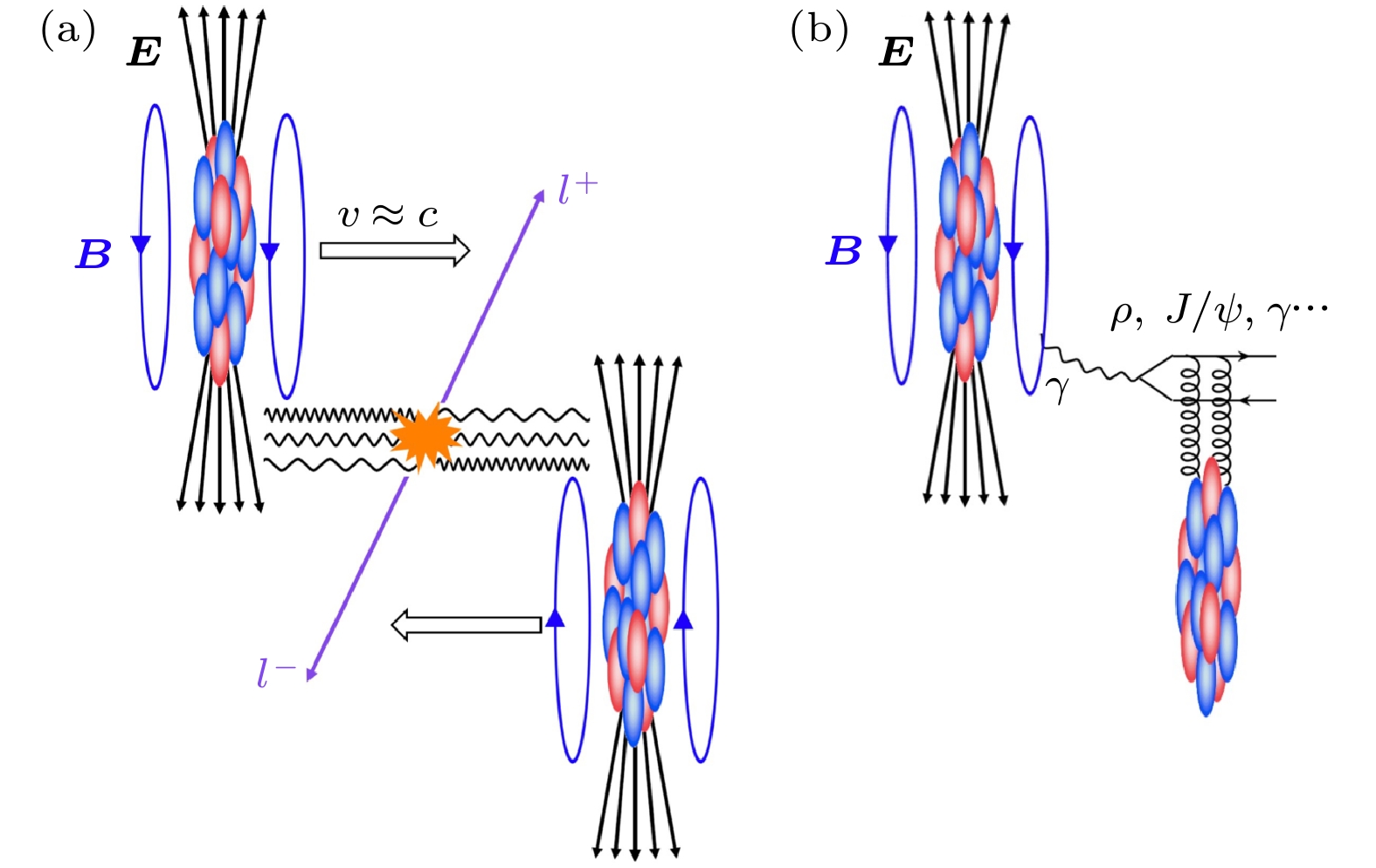
 下载:
下载:
